Safety Precautions
Important Information on Safe and Efficient Operation.
Read this Information Before Using your Headset.
- Listening to music or any other sound at a high
volume over time can cause permanent damage to
your hearing. Noise-induced hearing loss can occur
even when you are enjoying music on a personal
listening device. The user is responsible for proper
selection, use, care and maintenance of this device.
Improper selection use or maintenance may lead to
serious hearing loss.
- The output of the level dependent circuit of this
headset may exceed the external sound level.
-
Improper fit of this device will reduce its
effectiveness in lessening noise. Although hearing
protectors can be recommended for protection
against the harmful effects of impulse noise, the
Noise Reduction Rating (NRR) is based on the
attenuation of continuous noise and may not be an
accurate indicator of the protection attainable
against impulse noise such as gunfire. Constant or
repetitive exposure to impulse noise may lead to
serious injury, including temporary or permanent
deafness.
Product At-A-Glance
1. Cable assembly with PTT microphone for Motorola
2-way radio
2. Cable assembly for audio device
3. Headband
4. Microphone with wind protector
5. Battery compartment
6. Height adjustment slider
7. Ear cushion
8. Volume and Power Control
9. Ear cup
10. Audio input jack
Getting Started
Your Motorola headset amplifies surrounding sounds
such as voices, animals, and environmental sounds to
safe levels while providing protection against loud
s
ounds that can damage your hearing. Because of the
two separate microphones and circuit boards, you are
better able to pinpoint where a sound originates for
improved situational awareness. The earmuffs have 2
audio jack inputs for connection with the Motorola
FRS/GMRS Talkabout
®
2-Way radios and other input
devices such as MP3 players and scanners.
Installing the Batteries
1. Using the volume control knob on each ear cup, turn
the headset off.
2. Gently lift the foam flap on the inside of each ear cup
t
o expose the battery holder.
3. Insert two new N alkaline batteries into each ear cup
battery holder by following the polarity (+/-) markings
on the holder.
Replacing the Batteries
1. Using the volume control knob on each ear cup, turn
the headset off.
2. Gently lift the foam flap on the inside of each ear cup
to expose the battery holder.
3. Remove the old N alkaline battery by gently easing
each battery up and out of the battery compartment.
4. Insert two new N alkaline batteries into each ear cup
battery holder following the polarity (+/-) markings on
the holder.
Notes
1. Exercise care when removing batteries.
2. Do not use sharp or conductive tools to remove the
batteries.
3. Performance of the microphone amplifier can
deteriorate with battery usage.
4. New batteries will typically last over 220 hours of
operation.
5. Properly dispose of old batteries in accordance with
local environmental regulations.
6. Remove the batteries before storing your headset for
extended periods of time. Batteries corrode over time
and may cause permanent damage to your headset.
Fitting the headset
Adjust the height adjustment sliders downward from the
top to an appropriate position based on your head size.
Move the cups up and down until the cups are secured
over the ear. For best results, remove all hair from under
the cushion. Noise reduction will be adversely affected
by anything that impairs the seal of the earmuff cushions
against the head such as glasses or a hat. Height
Adjustment Sliders should be evenly extended from the
headband.
Placing the ear cups over each ear
The input jacks can face either forward or backward,
depending on how you intend to drape the cable
assembly when connecting to an audio device.
Removing and replacing damaged or worn-out ear seals
1. Hold the cup in one hand and place the fingers of the
other hand underneath the hard plastic ear seal
flange.
2. The ear seal and flange will snap off of the cup with
moderate force.
3. Put the new ear seal over the cup and snap into
place.
Continued on back
MHP71/MHP81
7
. The earmuff is equipped with an electrical audio
input jack. The user should check for proper
operation before use.
8. Two separate cord assembly cables are included.
One cable has a 2.5 mm connector and an in-line
microphone for use with your Motorola Talkabout
®
FRS/GMRS two-way radio. The second cable has
3.5 mm connector for use with other input devices.
Sound Attenuation Data for Hearing Protectors in the
USA. (ANSIS3.19-1974)
Tested and approved in accordance with ANSI S3 19:
1974 at Michaels & Associates, Inc. (in passive mode
with electronics off).
MHP71
MHP81
Sound Attenuation Data for Hearing Protectors in Canada.
Source: CSA Standard Z94.2-02
The MHP71 is rated CSA Class B.
The MHP81 is rated CSA Class B.
MHP71 MHP81
The NRR calculated from these laboratory-based
attenuation data is 21. Improper fit of this device will
reduce its effectiveness in attenuating noise. Consult
instructions for use for proper fit.
The level of noise entering a person’s ears when a
hearing protector is worn as directed is closely
approximated by the difference between the
A-weighted environmental noise level and the NRR.
EXAMPLE:
1. The environmental noise level as measured at the
ear is 92 dBA.
2. The NRR is 25 decibels. (dB)
3. The level of noise entering the ear is approximately
equal to 67 dBA.
Removing and replacing worn-out headbands
1. Hold one ear cup firmly in place with one hand.
2. Use your other hand to slide each pivot pin of the yoke
out of the cup’s rubber socket. A slight rotation of the
cup will help release the pin from the rubber socket.
3
. Repeat 1 and 2 above to remove the other cup.
4. Hold one ear cup firmly in place with one hand.
5. Rotate and press the ends of the yoke pins of the new
h
eadband into the 2 rubber sockets located on the ear
cup.
Connecting your audio player to your headset
1. Locate the cable assembly with the 3.5 mm plug at the
end.
2. With your headset off, plug the white and red 2.5 mm
connectors into the jacks on each cup. The headset
has no front or back. You should ensure that the left
and right connectors are plugged into the accessory
jack that matches your preferred way of wearing the
h
eadset.
3. With your player off, plug the headset’s single
connector into the player’s accessory jack.
4. Turn the music player on and adjust volume to a
comfortable listening level.
Connecting your Motorola Talkabout® 2-Way radio to
your headset
1. Locate the cable assembly with PTT microphone and
all black 2.5 mm connectors.
2. With your headset off, plug the white/red connectors
into the jacks on each cup. The headset has no front
or back. The 2-Way radio is monophonic, and the left
and right connectors can be plugged into either cup.
3. With your 2-way radio off, plug the 2.5 mm connector
into the radio’s accessory jack.
4. Turn the radio on and adjust the volume to a
comfortable listening level.
5. Hold the PTT microphone 2.5 cm from the mouth for
best audio clarity.
6. To transmit, press the PTT (Push-To-Talk) button. To
receive, release the button.
Amplification Control and Audio Connection
Adjust each volume control knob to the minimum comfort
level to maintain situational awareness. Amplification
does not exceed the recommended safe decibel level for
continuous operation. The volume control on the headset
only controls the volume of the amplification. To control
the volume of an external device use the device volume
adjustment.
IMPORTANT USER INSTRUCTIONS
1. The earmuffs should be regularly inspected for
serviceability.
2. If you encounter excessive crackling or distortion in
the speakers, turn off the volume controls and replace
the batteries with new N alkaline batteries.
3. If the distortion continues, contact the manufacturer.
The manufacturer information can be found in the
warranty section of this user guide.
4. Inspect the ear cushions for cracks or hard spots or
separation from the cups. Replace damaged or
worn-out ear seals.
5. After extended use, clean/disinfect ear seals with a
soft cloth and warm soapy water. DO NOT SUBMERSE
EARMUFFS IN WATER! Store in a cool, dry place. The
ambient temperature for storage should not exceed 55
degrees C (130 degrees F).
6. The microphone wind protector should be properly
secured. Replacement wind protectors are available
from the manufacturer.
Models MHP71/MHP81
ELECTRONIC EARMUFF
User Guide
MPH-UM-71/81
For More Information
For further information, you may call
Motorola Solutions, Inc.
at 1-800-638-5119 (U.S. and Canada),
e-mail us at giantintl@callcenter.com or visit us on the
Internet at motorolasolutions.com/talkabout.
Frequency, Hz
Minimum attenuation, dB
Class A Class B Class C
125 10 5 None
250 18 12 None
5
00
2
6
1
6
N
one
1
000
3
1
2
1
1
1
2000 31 23 13
3150 33 23 13
4000 31 21 11
6300 33 23 13
8
000
3
3
2
3
1
3


 1
1
 2
2
Motorola MHP61 User manual
Motorola MHP61 User manual
Motorola TALKABOUT KEM-PK14190-47A User manual
Motorola KEM-PK34301-03 Talkabout User manual
Motorola MT352R User manual
Motorola MT352R User manual
Motorola TalkAbout MH230 User manual
Motorola T5000 User manual
Motorola TalkAbout MR Series User manual
Motorola Talkabout 1884 User manual
Stalwart M550096 User manual
Harbor Freight Tools 46798 User manual
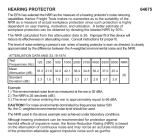 Western Safety 64675 Owner's manual
Western Safety 64675 Owner's manual
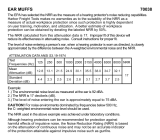 Western Safety Item 70038-UPC 792363700382 Owner's manual
Western Safety Item 70038-UPC 792363700382 Owner's manual
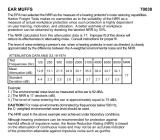 Western Safety 70038 Owner's manual
Western Safety 70038 Owner's manual
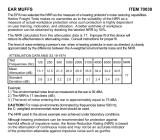 Western Safety 70038 Owner's manual
Western Safety 70038 Owner's manual
Harbor Freight Tools Industrial Ear Muffs User manual
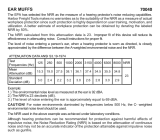 Western Safety Item 70040 Owner's manual
Western Safety Item 70040 Owner's manual
Harbor Freight Tools Reusable Corded Earplugs User manual
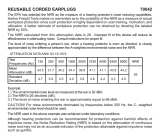 Western Safety 70042 Owner's manual
Western Safety 70042 Owner's manual







